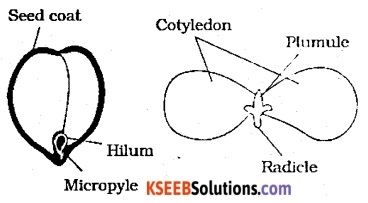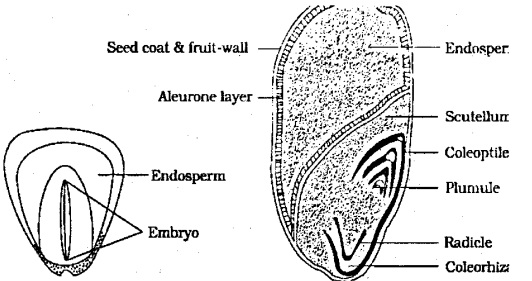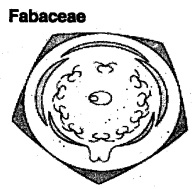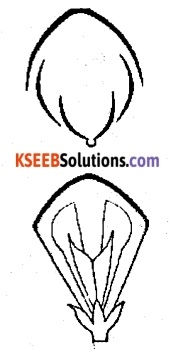You can Download Chapter 5 Morphology of Flowering Plants Questions and Answers, 1st PUC Biology Question Bank with Answers, Karnataka State Board Solutions help you to revise complete Syllabus and score more marks in your examinations.
Karnataka 1st PUC Biology Question Bank Chapter 5 Morphology of Flowering Plants
1st PUC Biology Plant Kingdom NCERT Text Book Questions and Answers
Question 1.
What is meant by modification of root?
Answer:
Root in some plants change their shape and structure and become modified to perform functions other than absorption and conduction of water and minerals. This change is called as the modification of root.
Question 2.
What type? of modification of root is found in the:
(a) Banyan tree
(b) Turnip
(c) Mangrove trees
Answer:
(a) Banyan Tree has roots called prop roots which are hanging structures that help in support.
(b) Turnip has tap roots which get swollen and store food.
(c) Mangrove trees are found in marshy area. The roots get modified into pneumatic structures providing extra passage to allow additional oxygen to the plant.
Question 3.
Justify the following statements on the basis of external features:
1. Underground parts of a plant are not always roots.
2. Flower is a modified shoot.
Answer:
- Underground parts of a plant are not always roots: In some plants stems remain underground to carry out some additional functions, like food storage and vegetative propagation. For example, Potatoes are modified form of underground stem.
- A flower is a modified shoot: When the stem takes on the role of general reproduction it is modified into a flower. That is why a flower is often called a modified root.
![]()
Question 4.
How is a pinnately compound leaf different from a palmately compound leaf?
Answer:
- In pinnately compound leaf a number of leaflets are present on a common axis. Example: Neem leaves.
- In palmately compound leaf, number of leaflets are attached at the common point.
Example: Cotton leaves.
Question 5.
Explain with suitable examples the different types of phyllotaxy.
Answer:
‘Phyllotaxy is the pattern of arrangement of leaves on the stem or branch.
This is usually of three types alternate, opposite and whorled.
- An alternate arrangement of leaves: In alternate type of phyllotaxy, a single leaf arises at each node in an alternate manner, as in China rose, mustard and sunflower plants.
- Opposite arrangement of leaves: In opposite type, a pair of leaves arise at each node and lie opposite to each other as in Calotropis and guava plants.
- Whorled Arrangement of leaves: If more than two leaves arise at a node and form a whorl, it is called whorled, as in Alstonia.
Question 6.
Define the following terms:
(a) aestivation
(b) placentation
(c)actinomorphic
(d) zygomorphic
(e) superior ovary
(f) perigynous flower
(g) epipetalous stamen
Answer:
(a) aestivation: The mode of arrangement of sepals or petals in floral bud with respect to the other members of the same whorl is known as aestivation.
(b) placentation: The arrangement of ovules within the ovary is known as placentation.
(c) actinomorphic: When a flower can be divided into two equal radial halves in any radial plane passing through the centre, it is said to be actinomorphic.
Example: Mustard, Datura, Chilli.
(d) zygomorphic: When a flower can be divided into two similar halves only in one particular vertical plane, it is zygomorphic.
Example: Pea, Gulmohar, Bean, Cassia.
(e) superior ovary: Also called as Hypogynous flower. In the hypogynous flower the gynoecium occupies the highest position while the other parts are situated below it. The ovary in such flowers is said to be superior.
Example: Mustard, China rose, Brinjal.
(f) perigynous flower: If gynoecium is situated in the centre and other parts of the flower are located on the rim of the thalamus almost at the same level, it is called perigynous – The ovary here is said to be half inferior.
Example: Pium, Rose, Peach.
(g) eplpetalous stamen: When stamens are ‘ attached to the petals, they are epipetalous.
Example: Brinjal.
Question 7.
Differential between
(a) Racemose and cymose Inflorescence
(b) Fibrous root and adventitious root
(c) Apocarpous and syncarpous ovary
Answer:
(a) Racemose and cymose inflorescence:
In racemose type of inflorescence the main axis continues to grow, the flowers are borne laterally in acropetal succession. Acropetal succession means that older flowers are at the base and younger flowers are near the apex. In cymose type of inflorescence the main axis terminates in a flower, hence is limited in growth. The flowers are borne in a basipetal order. In basipetal succession older flowers are at the apex and younger flowers are near the base.
(b) Fibrous root and adventitious root:
In monocotyledonous plants, the primary root is short lived and is replaced by a large number of roots. These roots originate from the base of the stem and constitute the fibrous root system, as seen in the wheat plant. In some plants, like grass, monstera and the banyan tree, roots arise from parts of the plant other than the radicle and are called adventitious roots.
(c) Apocarpous and syncarpous ovary:
When more than one carpel is present, they may be free as in lotus and rose and are called apocarpous. When carpels are fused as in mustard and tomato, they are termed syncarpous.
![]()
Question 8.
Draw the labelled diagram of the following:
(i) gram seed
(ii) V.S. of maize seed
Answer:


Question 9.
Describe modifications of the stem with suitable examples.
Answer:
Food storage:
Stems are modified to perform different functions. Underground stems of potato, ginger, turmeric, zaminkand, colocasia are modified to store food in them. They also act as organs of perennation to tide over conditions unfavorable for growth.
Tendrils:
Stem tendrils which develop from axillary buds, are slender and spirally coiled and help plants to climb such as in gourds (cucumber, pumpkins, watermelon) and grapevines.
Thorns:
Axillary buds of stems may also get modified into woody, straight and pointed thorns. Thorns are found in many plants such as citrus, Bougainvillea. They protect plants from browsing animals. Some plants of arid regions modify their stems into flattened (opuntia), or fleshy cylindrical (Euphorbia) structures. They contain chlorophyll and carry out photosynthesis.
Vegetative Reproduction:
Underground stems of some plants such as grass and strawberry, spread to new niches and when older parts die new plants are formed. In plants like mint and jasmine a slender lateral branch arises from the base of the main axis and after growing aerially for some time arch downwards to touch the ground. A lateral branch with short internodes and each node bearing a rosette of leaves and a tuft of roots is found in aquatic plants like Pistia and Eichhornia. In banana, pineapple, the lateral branches originate from the basal and underground portion of the main stem, grow horizontally beneath the soil and then come out obliquely upward giving rise to leafy shoots.
![]()
Question 10.
Take one flower each of the families Fabaceae and Solanaceae and write its semi-technical description. Also, draw their floral diagram after studying them.
Answer:

This family was earlier called Papilionoideae, a subfamily of family Leguminosae. It is distributed all over the world.
- Vegetative characters: Trees, shrubs, herbs, root with root nodules Stem: erect or climber
- Leaves: alternate, pinnately compound or simple, leaf base, pulvinate, stipulate, venation reticulate.
- Floral characters: Inflorescence: racemose Flower: bisexual, zygomorphic Calyx: Sepals five, gamosepalous, imbricate aestivation.
- Corolla: Petals five, polypetalous,
papilionaceous, consisting of a posterior standard, two lateral wings, two anterior ones forming a kneel (enclosing stamens and pistil), vexillary aestivation. - Androecium: ten, diadelphous, anther dithecous
- Gynoecium: Ovary superior, monocarpellary, unilocular with many ovules, style
- single
- Fruit: legume, seed, one to many, non- endospermic
Floral Formula:

- Economic Importance: Many plants belonging to the family are sources of pulses (gram, arhar, sem, moong, soyabean); edible oil (soyabean, groundnut); dye (indigofera); fibres (sunhemp); fodder (Sesbania,Trifolium), ornamentals (lupin, sweet, pea); medicine (muliathi).

It is a large family, commonly called as the ‘potato family’. It is widely distributed in tropics, subtropics and even temperate zones
Vegetative Characters:
Plants mostly herbs, shrubs, and small trees
- Stem: herbaceous rarely woody, aerial; erect, cylindrical, branched, solid of hollow, hairy or glabrous, underground stem in potato (Solanum tuberosum)
- Leaves: alternate, simple, rarely pinnately compound, exstipulate; venation reticulate
Floral Characters - Inflorescence: Solitary, axillary or cymose as . in Solanum
- Flower: bisexual, actinomorphic
- Calyx: sepals five, united, persistent, valvate aestivation.
- Corolla: petals five, united; valvate aestivation Androecium: stamens five, epipetalous
- Gynoecium: bicarpellary, syncarpous; ovary superior, bilocular, placenta swollen with many ovules.
- Fruits: berry or capsule
- Seeds: many, endospermous
- Floral Formula:

- Economic Importance
Many plants belonging to this family are source of food (tomato, brinjal, potato), spice (chilli); medicine (belladonna, ashwagandha); fumigatory (tobacco); ornamentals (petunia).
Question 11.
Describe the various types of placentations found in flowering plants.
Answer:
The arrangement of ovules within the ovary is known as placentation. The placentation is of different types namely
(a) marginal: In marginal placentation the placenta forms a ridge along the ventral suture of the ovary and the ovules are borne on this ridge forming two rows, as in pea.
(b) Axile: When the placenta is axial and the ovules are attached to it in a multilocular ovary, the placentation is said to be axile, as in China rose, tomato and lemon.
(c) Parietal: In Parietal placentation, the ovules develop on the inner wall of the ovary or on peripheral part. Ovary is one chambered but it becomes two-chambered due to the formation of the false septum. Example: Mustard and argemone. When the ovules are borne on a central axis and septa are absent, as in Dianthus and Primrose the placentation is called free central
(d) Basal: In basal placentation, the placenta develops at the base of the ovary and a single ovule is attached to it, as in sunflower, marigold.
![]()
Question 12.
What is a flower? Describe the parts of a typical angiosperm flower.
Answer:
Flower is the reproductive unit in angiosperms:
It is meant for sexual reproduction. A typical flower has four different kinds of whorls arranged successively on the swollen end of the stalk or pedicel, called thalamus or receptacle. These are calyx, corolla, androecium and gynoecium.
Calyx:
The calyx is the outermost whore of the flower and the members are called sepals.
Generally, sepals are green leaf-like and protect the flower in the bud stage. The calyx may be gamosepalous (sepals united) or polysepalous (sepals free).
Corolla:
Corolla is composed of petals. Petals are usually brightly colored to attract insects for pollination may be free or united. The shape and colour of corolla vary greatly in plants. Corolla may be tubular, bell-shaped, funnel-shaped or wheel-shaped.
Androecium:
Androecium is composed of stamens. Each stamen which represents the male reproductive organ consists of a stalk or a filament and an anther. Each anther is usually bilobed and each lobe has two chambers, the pollen sacs. The pollen grains are produced in pollen-sacs. When stamens are attached to petals, they are epipetalous as in brinjal or eptphyllous when attached to perianth as in the flowers of lily. The stamens may be united into one bundle (monoadelphous) as in China rose, or two bundles (diadelphous) as in pea, or into more than two bundles (polyadelphous) as in citrus.
Gynoecium:
Gynoecium is the female reproductive part of the flower and is made up of one or more carpels. A Carpel consists of three parts namely stigma, style, and ovary. Ovary is the enlarged basal part, on which lies the elongated tube, the style. The style connects the ovary to stigma. The stigma is usually at the tip of the style and is the receptive surface for pollen grains. Each ovary bears one or more ovules attached to a flattened, cushion-like placenta.
Question 13.
How do the various leaf modifications help plants?
Answer:
- Tendrils: Leaves are converted into tendrils for climbing as in pear or into spines for defense as in cacti.
- Bulb: The fleshy leaves of onion and garlic store food. In some plants such as Australian acacia, the leaves are small and short-lived. The petioles these plants expand, become green and synthesis food. Leaves of certain insectivorous plants such as pitcher plants, Venus flytrap are also modified leaves.
Question 14.
Define the term inflorescence. Explain the basis for the different types of Inflorescence in flowering plants.
Answer:
The arrangement of flowers on the floral axis is turned as inflorescence. Depending on whether the apex gets converted into a flower or continues to grow, two major types of the inflorescence are defined-racemose and cymose. This forms the basis for the different types of inflorescence in flowering plants.
Question 15.
Write the floral formula of an actinomorphic, bisexual, hypogynous flower with five united sepals, five free petals, five free stamens and two united carpels with superior ovary and axile placentation.
Answer:

Question 16.
Describe the arrangement of floral members in relation to their insertion on thalamus.
Answer:
Based on the position of calyx, corolla and androecium in respect of the ovary, on thalamus, the flowers are described as
(a) hypogynous:
In the hypogynous flower, the gynoecium occupies the highest position while the other parts are situated below it. The ovary in such flowers is said to be superior. Example: Mustard, China rose, brinjal.
(b) Perigynous:
If gynoecium is situated in the centre and other parts of the flower are located on the rim of the thalamus almost at the same level, it is called perigynous. The ovary here is said to be half inferior.
Example: Plum, Rose, Peach.
(c) Epigynous:
In epigynous flowers the margin of thalamus grows upward enclosing the ovary completely and getting fused with it, the other parts of flower arise above the ovary. Hence, the ovary is said to be inferior.
Example: Guava, Cucumber, Sunflower.
1st PUC Biology Plant Kingdom Additional Questions and Answers
1st PUC Biology Plant Kingdom One Mark Questions
Question 1.
Garlic is a good example of
Answer:
bulb
Question 2.
A good example of a stolon bearing plant is
Answer:
Jasmine.
Question 3.
Bombax (silk cotton) is a good example of
Answer:
multifoliate compound leaf.
Question 4.
Name the kind of phyllotaxy in Hibiscus.
Answer:
Alternate phyllotaxy.
Question 5.
Name two plants that produce rhizome.
Answer:
Ginger, Turmeric.
![]()
Question 6.
What is heterophylly?
Answer:
Heterophylly refers to the presence of leaves of more than one shape on a plant.
Question 7.
What is a cladode?
Answer:
Cladode is a phylloclade of one or two ‘ internodes.
Question 8.
What is pulvinus?
Answer:
The swollen leaf base is called pulvinus.
Question 9.
Define morphology.
Answer:
Morphology is the branch of science or biology that studies the external features of an organism.
Question 10.
What are adventitious roots?
Answer:
Adventitious roots are those roots which arise from any part of the plant, other than the radicle.
Question 11.
What are tendrils?
Answer:
Tendrils are slender, spirally coiled structures that help the weak-stemmed plants to climb on the support.
Question 12.
What is a leaf lamina?
Answer:
The leaf lamina is the green expanded part of the leaf with veins and veinlets.
Question 13.
What is a bract?
Answer:
Bract is a reduced leaf-like structure found at the base of the pedicel of a flower.
Question 14.
What is a staminode?
Answer:
Staminode is a sterile stamen, that does not produce pollen grains.
Question 15.
What are parthenocarpic fruits?
Answer:
Parthenocarpic fruits are those fruits which develop without fertilisation of the ovary
1st PUC Biology Plant Kingdom Two Marks Questions
Question 1.
How is a stolon different from a sucker in plants? Give an example of each.
Answer:
| Stolon | Sucker |
| It is an aerial branch of stem that bends down and touches the ground | It is a branch of stem arising from underground part of the main stem |
| When the tip is buried in the soil, buds produce adventitious roots above the ground Eg: Jasmine | It grows horizontally under the ground and produces a leafy shoot Ex: Chrysanthemums |
Question 2.
What is root cap? What is its function?
Answer:
Root cap is the thimble-like structure that covers the root apex/tip. It protects the tender apex of the root as it penetrates through the soil.
Question 3.
What are nodes and internodes?
Answer:
Nodes are the regions on the stem where leaves arise. Internodes are the regions on the stem between two nodes.
Question 4.
What is a petiole? Mention the function of petiole.
Answer:
The stalk of the leaf is called petiole
Functions:
- In helps to hold the leaf blade to the light
- It also helps the blade to flutter in wind.
Question 5.
What is a seed? What are the two major parts a seed consists of?
Answer:
A fertilised and mature ovule is called a seed. A seed has two parts.
- An embryonal axis
- One or two cotyledons
Question 6.
What are trimerous flowers? Which group of plants has trimerous flowers?
Answer:
Trimerous flowers are those where the floral appendages are in threes or multiples of three. Monocotyledonous plants generally have trimerous flowers.
Question 7.
What are coleoptile and coleorhiza?
Answer:
- Coleoptile is the sheath that covers and protects the plumule fn cereal grains.
- Coleorhiza is the protective sheath of the radicle in cereal grains.
Question 8.
What is eieurone layer? Where is it found?
Answer:
Aleurone layer is a layer of cells rich in proteins, that separates the embryo from the endosperm in cereal grains like rice, maize, wheat etc.
Question 9.
What is endosperm? Name two plants where ’ endosperm is absent.
Answer:
Endosperm is the tissue that stores food materials for the developing embryo, it develops as a result of triple fusion in double fertilization. Endosperm is absent in
- pea
- Bean
- Mustard
Question 10.
Name the plant and its family, from which colchicine is obtained.
Answer:
Colonicine is obtained from Colchicum autumnale. The plant belongs to the family Liliaceae.
1st PUC Biology Plant Kingdom Three Marks Questions
Question 1.
How are plants classified based on their life span? Give an example each?
Answer:
Based on the life-span, plants are classified into
- Annuals – plants which complete their life-cycle in one season eg: mustard, sunflower
- Biennials- plants which complete their life-cycle in two seasons
eg: radish, beetroot - Perennials – plants which live for a number of years and produce flowers and fruits at specific seasons every year eg: mango, termarind.
Question 2.
Define venation. Differentiate between reticulate and parallel venation.
Answer:
Venation refers to the arrangement of veins and veinlets on the lamina of leaf
| Reticulate venation | Parallel venation |
| The midrib & other branches of veins are irregularly distributed to form a network | The veins run parallel to one another and no network is formed on lamina |
| It is characteristic of dicot plants | It is characteristic of monocot plants |
Question 3.
How is marginal placentation different from parietal placentation? Give an example of each.
Answer:
| Marginal placentation | Parietal placentation |
| It is found in the monocarpellary, unilocular ovary. | It is found in syncarpous ovaries. |
| Placentae are found along the ventral suture, formed by the fusion of margins of a carpel. eg: pea, bean | carpels are fused laterally and the placentae develop on the ovary wan as many as numbers of carpels eg: cucurbits, mustard. |
Question 4.
What is a floral diagram? Describe.
Answer:
A floral diagram is the diagrammatic representation of the ground plan of a flower. It provides information about.
- The number of floral parts
- Their arrangement and interrelationships among various floral parts
The position of mother axis with respect to the flower is indicated by a dot on top of the floral diagram – calyx, corolla, androeium and gynoeium are represented in successive whorls with calyx being the outermost.
Question 5.
What are pneumatophore? How do they help the plant? Name an example.
Answer:
Roots that grow vertically upwards and come” above the soil surface are called pneumatophores. They bear openings called pneumathodes for exchange of gases.
This feature is an adaptation for plants growing in marshy/swampy areas, where oxygen is deficient in the soil. These roots help the plants to get oxygen from the air for respiration. Eg: Rhizophora.
![]()
1st PUC Biology Plant Kingdom Five Marks Questions:
Question 1.
What are herbs, shrubs and trees among plants? Give an example for each. What is the criterion for this classification?
Answer:
(a) Herbs: They are small seasonal plants with soft stem
Eg: Mustard
(b) Shrubs: They are medium sized plants with woody stems that branch profusely from the base and attain a bushy appearance
Eg: Rose
(c) Trees: These are plants with a short and tall trunk with profuse branching.
Eg: Mango, Neem. Plants are classified on the basis of height and strength of stems.
Question 2.
What is a flower? Describe the parts of typical angiosperm flower.
Answer:
A flower is a modified shoot, meant for reproduction in angiosperms. A typical flower has a stalk called pedicel and four different kinds of appendages arranged in successive whorls on the swollen end of the axis called thalamus. The outermost whorl is the calyx, and consists of sepals. The next inner whorl is the corolla and consists of petals. The third whorl is the androeium which is composed of stamens. The fourth and innermost whorl is the gynoecium which is composed of carpels. The calyx and corolla are called accessory whorls and the androeium and gynoecium are called essential reproductive whorls.
Question 3.
Describe vexillary aestivation along with a diagram name an example.
Answer:
It is found in papilionaceous corolla. The posterior vexillum or standard petal is completely external and overlaps the two lateral wing petals.

The other margin of each of the wing petals overlaps the margin of the keel petals. Keel petals are the smallest and anterior and their other margins are fused together.
Eg: Pea, Bean
Question 4.
Write five differences between a dicot seed and a maize grain.
Answer:
| Dicot seed | Maize Grain |
| It is a seed that has developed from the ovule | It is a single-seeded fruit, the ovary modified |
| The seed coat is distinct from the fruit wall | The seed coat is completely fused with the pericarp single cotyledon |
| Two cotyledons Endosperm is absent | Single cotyledon Endosperm is present |
| There is no proactive sheath for the plumule and radicle | The plumule is protected by coleoptile and radicle by coleorhiza |
Question 5.
Name one plant of Fabaceae, that yields each of these:
Answer:
- Edible oil – Arachis hypogea
- Dye – Indigofera
- Fibres -Crotalariajuncea
- Medicine – Trigonella
- Fodder -Trifolium